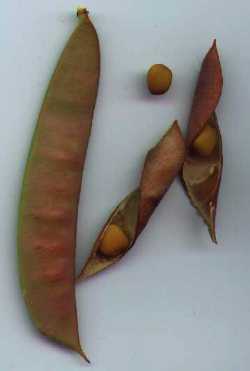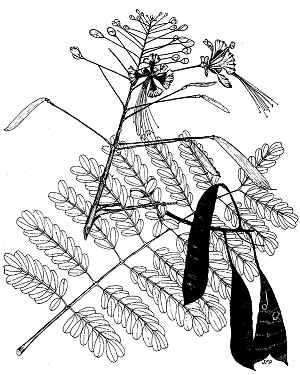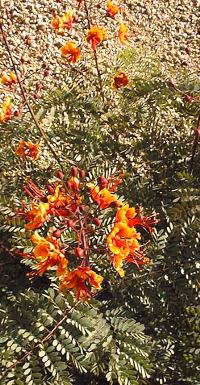Red Bird of Paradise, Pride of Barbados
Scientific Name: Caesalpinia pulcherrima (L.) Sw.
Synonym: Poinciana bijuga, Poinciana pulcherrima
Family: Fabaceae
Sunset®: 12-16,18-23
USDA: 8b-10
Frost Tolerance: Leaves hardy to 30°F (-8°C), regrows when frozen to the ground, root hardy to 15°F (-10°C)
Sun Exposure: Full sun
Origin: Central America, northwestern South America, West Indies
Growth Habits: Evergreen bush fast growing to 6 to 15 feet tall and wide (1.8-4.5 m); bipinnate leaves, 8 to 14 inches long (20-35 cm), 3 to 9 pairs of pinnae, each with 7 to 15 pairs of leaflets
Watering Needs: Infrequent deep watering

This bush is generally known in Phoenix as Mexican Bird of Paradise, name that really belongs to C. mexicana. The Red Bird of Paradise is a relatively frost sensitive Caesalpinia, and it is generally better to trim it close to ground in winter. This keeps it more compact without seeming to delay it in spring. Seeds are toxic.
'Phoenix' is a yellow form.

Pride of Barbados (Caesalpinia pulcherrima), leaf and fruit, U.S.D.A. Drawing, courtesy Hunt Institute
Culture:
Plant in spring 6 feet apart. Trim anytime for compactness. The canes tend to freeze in all but the warmest areas, and even if they don't, the new growth in April is somewhat ungainly. For this reason many gardeners cut the bush to the ground at the end of November, and it will grow back green and compact in mid spring.
Propagation:
The seeds grow fairly easily, but they should be sanded lightly for better result. Sanded seeds absorb water better and grow faster. If you look around the bushes, you might find some young seedlings, they are recognizable even young because of their bipinnate leaves (i.e. there is a main leaf stem, on which you have secondary leaf stems, on which you have the leaflets) most other generally similar seedlings like paloverde or mesquite are simply pinnate (the leaflets are connected directly to the main stem).
Desert-Tropicals is dedicated to provide gardening advice, gardening ideas, and information about flower of all kind for landscape and collections.We try to check carefully the identification of the plants on the illustrations as well as the other information from the page, but occasionally errors do occur. if you notice anything that needs to be changed please contact us.Thanks.
© 1998-2020 Philippe Faucon, All Rights Reserved.
